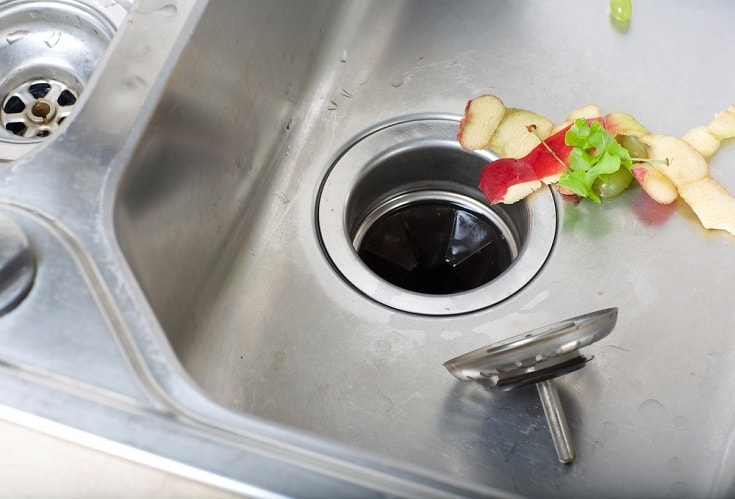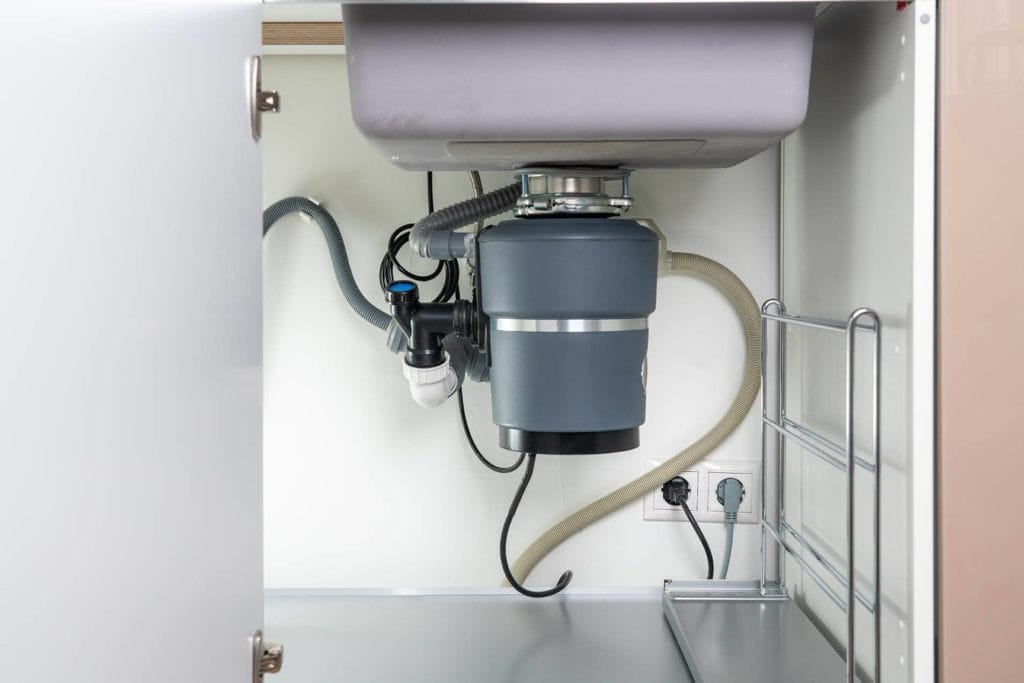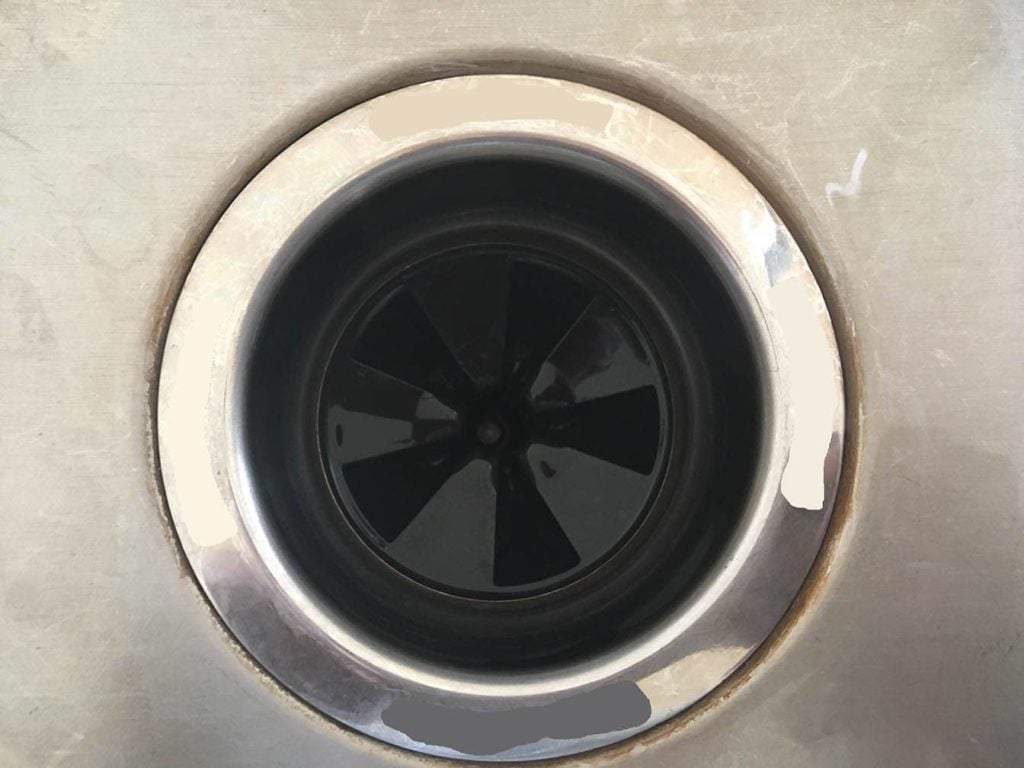How to Unclog a Garbage Disposal (7 Quick & Easy Steps)
-
- Last updated:


A garbage disposal can be a great asset to have in any kitchen. All that food residue that’s a pain to scrape into the trash is easily removed with a well-working disposal. The important phrase here, however, is well-working. Unfortunately, these little machines can be temperamental and having a broken one can be a nuisance.
That is, of course, if you don’t know these 7 easy ways to get your disposal back up and running. In the article below, we will outline how to get your garbage disposal back on track. Not only will we share these DIY remedies, but we will also add some troubleshooting methods for tougher problems within the eight, plus give you some tips for keeping your disposal working well.
If you have a sink disposal that is on the fritz, or you find yourself constantly trying to fix it with little success, keep scrolling to find out what to do next.
Why Garbage Disposals Gets Clogged
Before we give you tips on how to unclog this machine, we wanted to briefly go over why it gets clogged or jammed in the first place. The most common reason for one to stop working is because there is something caught inside of it.
Typically, you will find that there are food items that are too big, or there is a foreign object inside the unit. On the other hand, it could be due to built-up debris, a clog in your main drain line, or a motor issue. Thankfully, we have a solution for clearing up all of these issues, not to mention, tips for preventing them.

7 Steps to Unclog Your Garbage Disposal
1. Unplug the Unit
The first thing you always want to do before attempting any repairs outside the normal functions is to unplug your garbage disposal. Better yet, it is wise to turn the circuit breaker off for that area. That way, there will be no mistakes, plus some disposal’s electric cords can be out of reach.

2. Inspect the Disposal
In many cases, the reason your disposal is not working is due to a foreign object (like a fork) has become lodged in the mechanism. It could be a larger chunk of food, as well. Before you get into any invasive maneuvers, use a flashlight to look inside the machine. If there is something stuck, use a pair of pliers (needle nose usually works best) to remove the debris. If you don’t see anything visible, you can move onto the next step.
3. DIY Cleaner
If you don’t see a large piece of food or other object, you could be dealing with a build-up of smaller food particles. A simple DIY solution can clear this right up. Take a look at the steps below.
- Step One: In a bowl, combine a ¼ cup baking soda and a ½ cup vinegar.
- Step Two: Mix and pour directly into the sink while the mixture is still fizzing.
- Step Three: Allow the mixture to sit until the fizzing has come to a stop.
- Step Four: Turn on your hot water and allow it to run for 3 to 5 minutes.
Doing this procedure will typically unclog any small food particles and other debris that might be caught. Once you are done with the hot water, try to use the disposal and see if it drains. If not, move onto the next step.
4. Repeat Step Three
Though it might not seem deserving of its own step, it is important. The baking soda and vinegar mixture is a great solution, but it may need to be done more than once depending on how deep and thick your clog is. For example, you may have a small clog right at the drain point with another one further down the pipe. The initial fizz will get rid of the first clog, but you will need to do another for the one further down.
We recommend trying this about three times before moving onto the next step to ensure you are getting to the clog. Also, don’t underestimate the power of hot water. Allowing it to run as hot as possible is a great cure for a lot of residues that could be stopping your garbage disposal from working.
5. Use a Plunger
If running the hot water and the DIY solution has not made a difference, you could be dealing with a tougher clog deeper in your pipes. This is the time to pull out the plunger. With that being said, you don’t want to go at it with no plan. Using the plunger in a specific way will be more effective at removing the blockage.
- Step One: The first step is only necessary if you have a dishwasher. Often times, the dishwasher and garbage disposal lines are intertwined with one another. You want to start by clamping off the dishwasher line (make sure the power is off to this appliance, as well). If you plunge while the line is attached, you run the risk of popping it off potentially causing a flood the next time you use it.
- Step Two: Fill the sink so just the bottom is covered with water. Hot water is best here, as well. When you push the plunger into the water, the bottom rim should be covered, but it should not be any higher. This will help give you suction.
- Step Three: Use the plunger as normal for about 60 seconds before removing it. If the water doesn’t drain, repeat the process a few more times to dislodge the block.
At this point, if you are unable to clear the debris you either have a very difficult clog in your main drain line that will require the services of a professional, or there is another issue at work. So, before you make that expensive phone call, ask yourself whether your garbage disposal is making any noise when it’s turned on?
6. Check the Reset Button
It is important to note that garbage disposals that need to be reset won’t necessarily be completely dead, as it is still an electrical machine that is plugged in. If you turn the machine on and it makes a faint, high-pitched noise, it may need to be reset.
Most reset buttons are located near the bottom of the disposal, but different brands have different designs. That being said, the button is usually red and will be labeled. You can also refer to your user’s manual, or look it up online if you are unsure.
For this step, you will need to have the power on. Make sure the circuit breaker is in the on position, and the unit is plugged in. Press the reset button and wait about 15 seconds. Turn on the water and try running the disposal. If the water drains, you have found your culprit, if not, we have one more trick up our sleeves.

7. Blade Jams
In some cases, the blades in your garbage disposal may be jammed by something you can’t see. They may have seized up unexpectedly, or they could have some gunk preventing them from moving. To check that your blades are moving as they should, we have a quick solution.
For this step, you want to turn your circuit breaker back off and make sure the disposal is unplugged. At the bottom of the motor (you will likely have to lie down under the sink), there is a hex socket. Grab an Allen wrench and find the correct size. Turn the hex key in both directions to make sure nothing is stopping it from moving. Typically, half a turn with the Allen wrench is sufficient.
If this also has no effect, we are afraid it’s time to make that call. You never want to loosen any other bolts or screws on your appliance, nor do you want to mess with any wires. Doing so is not only dangerous for you, but you can easily cause a lot more damage to the machine. Instead, call in a professional plumber for help.

How to Prevent a Clogged Garbage Disposal

If you have a problem so big you had to call in the big guns, you are likely not enthusiastic about letting it happen again. Even smaller clogs and problems are a pain and can take some time to fix. With that in mind, we have shared some tips to keep your garbage disposal working in good order.
- Only Small Pieces: You want to ensure you are only sending small scraps of food down the disposal. Larger pieces can get caught or cause a clog as the smaller particles build-up behind them.
- Watch Out for Bones: Bones should also be avoided. Your disposal is not designed to handle objects that are this tough. Make sure any chicken bones or the leftover rib bones make it to the trash can.
- Foreign Objects: Items that are not food should never be put down your disposal. Forks, knives, and spoons are easy enough to see, but other items like toys, paper towels, and pieces of sponge can cause serious issues.
- Avoid Oil and Grease: Ever heard the saying oil and water don’t mix? That’s because water does nothing against oil or grease. Make sure that you dispose of cooking oils correctly. Over time, they can build up in your disposal and pipes creating blocks that can often be hard to reach. On a side note, don’t flush them either as it will cause the same issue. Use a container to safely throw them in the trash.
- Chemical Cleaners: You want to avoid reaching for chemical solutions to clear clogs like Drain-O. They often don’t work as well as our DIY tips, plus the corrosive chemicals will wear down the components of your disposal and eat away at your pipes
- Keep it Fresh and Clean: Finally, take care of any small issues as they appear. If you notice your garbage disposal is draining slowly, do a baking soda and vinegar clean right away. Also, you can send a cut-up lemon down there every couple of weeks to keep your disposal smelling fresh.

Conclusion
Non-working garbage disposal is not only annoying but can be hard to solve if you let it get out of hand. The best thing to do is remove clogs and debris right away to keep everything working correctly. The seven tips above will aid you to repair any issues, and keep you from having to make a potentially costly phone call to a professional.
Related Reads:
- How Often Should You Clean Your Garbage Disposal?
- How to Unclog Your Kitchen Sink Drain (Quick & Easy)
- 14 Things Not to Put in a Garbage Disposal & 4 Safer Choices
- How Does a Garbage Disposal Work? Everything You Need to Know!
Featured Image Credit: Tolikoff Photography, Shutterstock
Contents

